|
http://www.drachenarchiv.de/Seiten/f_flugtechniker.html
Schlesischer Flugsport Club "Schlesischen Flugsport-Vereins in Breslau"
[ ] ?
http://aviaebooks.de/attachments/File/IHV_FlSp_Gesamt_1908-1944.pdf
[ ] ? Henry Adams ... book? Flight ?
http://www.ushawks.org/forum/viewtopic.php?f=22&t=1072&p=4830 |
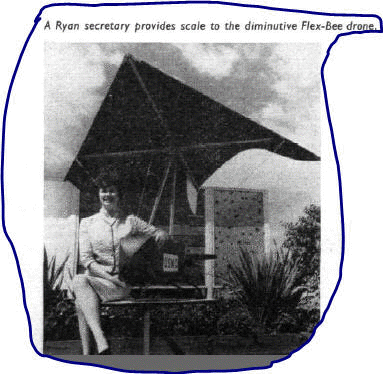
As published in FLIGHT International on publication date of
August 1, 1963. |
|
|
|
http://farm6.static.flickr.com/5014/5419873205_80bb02d330_b.jpg |
http://www.tattoosinflight.com/content/CurtissJennyBarnstormers_12C8C/curtiss_jn4_jenny_barnstormer_airplane_tattoo.jpg
The A-frame as undercarriage still may be a place to hang from!!!
Barnstormers delight! |
 Notice that on
biplane hang gliders: many have the hung pilot, especially
tensionally held by the struts and wires from the upper wing while holding
the lower spar (TCF basebar); the frequent two central frame uprights near
the pilot are essentially the uprights or downtubes of a TCF with perhaps
nearly parallel sides and an apex at the zenith infinite point; but some
are canted so that the apex is in the craft or above the craft or
virtually present via extension. The Wright Brothers essentially
were tensionally hanging from the lift of the upper wing of their biplane
gliders and kites....with two central uprights as part of the frame...and
with a holding front spar region. A-frame is essentially present in many
biplane hang gliders. Notice that on
biplane hang gliders: many have the hung pilot, especially
tensionally held by the struts and wires from the upper wing while holding
the lower spar (TCF basebar); the frequent two central frame uprights near
the pilot are essentially the uprights or downtubes of a TCF with perhaps
nearly parallel sides and an apex at the zenith infinite point; but some
are canted so that the apex is in the craft or above the craft or
virtually present via extension. The Wright Brothers essentially
were tensionally hanging from the lift of the upper wing of their biplane
gliders and kites....with two central uprights as part of the frame...and
with a holding front spar region. A-frame is essentially present in many
biplane hang gliders. |
|
Eric Raymond: "I
had a rigid wing hang glider with diffuser tips and I tried to do forward
tumbles with it. I thought the glider was strong enough to handle the
loads of a tumble. It had big elevons which when tipped down would make a
flying wing nose down radically, which was my intention. I built a harness
with three carabiners. One you hook in normally. The others you hook in to
the other two corners of the control bar after launch. You are just
suspended in the triangle when you go upside down." |
|
Grade ŽLibelleŽ 1909 See:
http://4.bp.blogspot.com/_n0XAi_25HEc/Si4zvUQiZ5I/AAAAAAAAAV8/kiS_ZhCareE/S660/Grade+001.jpg
prsented on his page
See also:
http://aviatik1911konstruktionsplne.blogspot.com/ See also
http://www.airport-data.com/aircraft/photo/724117.html |
 |
|
 by bobk »
Wed Jun 20, 2012 7:56 pm by bobk »
Wed Jun 20, 2012 7:56 pm
Wow Tony!!!
That's a rigid wing with a triangular control frame ... from 1929!!!
 Click image to enlarge this.
Click image to enlarge this.
It even has a safe-splat (or Safe-Spratt?) landing system. 
 by Merlin »
Thu Jun 21, 2012 5:34 am by Merlin »
Thu Jun 21, 2012 5:34 am
A basic fact that is almost never mentioned is the debt
modern hang gliders owe to sailing technology. Cable-stayed
structures, sail design and fabrication, battens, deflexors,
readily available hardware and expertise - in short almost
EVERYTHING. Sailing vessels are in fact "air"-craft.
Also, a great deal goes into describing the "hero" version of
history. I prefer to imagine technology evolving by the
transmission and shuffling of ideas thru the population. A
graphical depiction of this would be a network that resembled a
bush with many interconnections, not a linear list of the
accomplishments of our "heros".
The standard Rogallo was to my mind a very simple modification
to the simple diamond kite we all flew as kids. The "A-frame" -
or "trapeze bar" as it was often called back then - we are led
to believe now by some that this was a work of creative genius.
Well if people are modifying flat kites on bodies of water, with
sail boats presumably all around, with there cable braced tubes
EVERYWHERE - are we supposed to be surprised when they are
re-purposed? ~Merlin
|
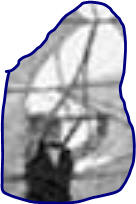 Katydid by Chanute with
TCF. Note posted in USHawks forum in
Quadruplanes Katydid by Chanute with
TCF. Note posted in USHawks forum in
Quadruplanes |
|
EMAIL TCF studies [ ] |
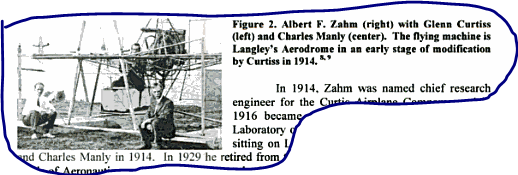 [ ] Explore Langley's
Aerodrome and versons ...
http://books.google.com/books?id=-YJZ3jMMk1MC&lpg=PA316&ots=friiBmA4Tj&dq=%22John%20D.%20Nicolaides%2C%22%20parafoil&pg=PA308#v=onepage&q=%22John%20D.%20Nicolaides,%22%20parafoil&f=false
Aerospace Engineering Education During The First Century Of Flight
By Barnes Warnock McCormick, Conrad F. Newberry, Eric Jumper [ ] Explore Langley's
Aerodrome and versons ...
http://books.google.com/books?id=-YJZ3jMMk1MC&lpg=PA316&ots=friiBmA4Tj&dq=%22John%20D.%20Nicolaides%2C%22%20parafoil&pg=PA308#v=onepage&q=%22John%20D.%20Nicolaides,%22%20parafoil&f=false
Aerospace Engineering Education During The First Century Of Flight
By Barnes Warnock McCormick, Conrad F. Newberry, Eric Jumper
[ ] . Saar, "LIFE", September, 1968 ? What is this?
[ ] 3. Nicolaides, J. D., "On the Discovery and Research of the Parafoil",
Nov. 1965, International
Congress on Air Technology, Little Rock, Ark. [[Notice that papers
regard work done before the date of the delivered paper.]]
[ ] 4. Nicolaides, J. D. and Knapp, C. F., "A Preliminary Study of the
Aerodynamic and Flight Performance of the Parafoil",
July 8, 1965, AIAA
Conference on Aerodynamic Deceleration,
University of Minnesota. |
|
Aerodynamics in 1804 by Yates in Flight
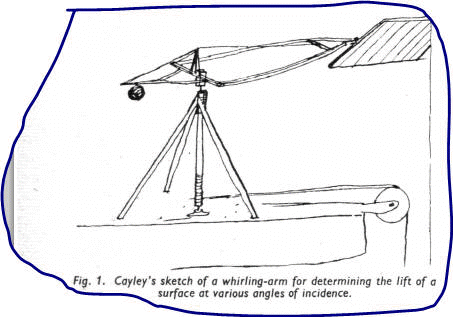
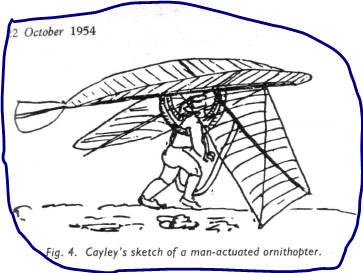 Flight article in
October 1954 about 1804c aerodynamics. Notice the supporting
non-flapping wing for gliding while further area in flapping wings were
sketched by Cayley. He flew unmanned models that worked well; see article
and history. Flight article in
October 1954 about 1804c aerodynamics. Notice the supporting
non-flapping wing for gliding while further area in flapping wings were
sketched by Cayley. He flew unmanned models that worked well; see article
and history. |
 Click image to enlarge this.
Click image to enlarge this.![]()